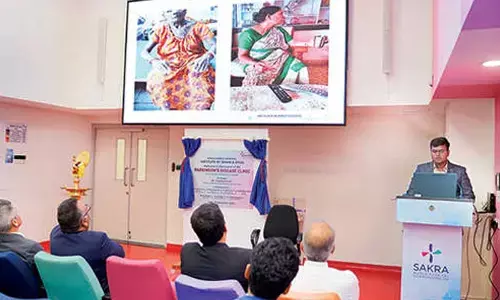Solar power generation fails to gain momentum in Nellore
 A pictorial representation of a solar power generation unit
A pictorial representation of a solar power generation unitThough solar power production was planned on a massive scale in the district, still, it was not materialised due to changing government policies.
Nellore: Though solar power production was planned on a massive scale in the district, still, it was not materialised due to changing government policies. Solar power production unit was planned in Chejarla and Sangam mandals some time ago, the promoters failed to float the units due to no support from the previous State government.
In fact, the district has potential for solar energy where the strength is 5.15 kwh/square metre as against the highest of 5.27 kwh/square metre in Anantapur. Heatwave conditions are increasing year by year and the government has been failing to tap the resource.
The estimated potential as per solar irradiance in the State is from 5 to 7 kilowatt-hour per square metre in Andhra Pradesh which is among few States with a greater number of sunny days. Experts in alternative energy say wasteland percentage in the district is more when compared to Anantapur, Guntur and Kurnool districts.
The district is having around 38 per cent of wastelands along with groundwater reserves for cleaning huge solar photovoltaic power plants. They also say Andhra Pradesh is equal to desert-areas of Rajasthan in terms of 20 per cent of Capacity Utilization Factor (CUF) where output from one KWp (Kilowatt peak) panel/day is 4.80. APSPDCL proposed 50 MW of solar power generation during 2018-19 and there have been no sincere efforts to complete the projects.
It also planned domestic solar units for reducing pressure on traditional power. But the proposals are also under dormant stage and officials said they would consider after pilot project in Tirupati and other places are successful.
"We are waiting for a new policy by the State government on non-renewable energy. Though the Centre had stopped support last year for some projects, State government earlier had continued. There is a huge potential for the solar power in the district and entrepreneurs should be encouraged to start the units," said a senior official from the NREDPCAP.
Now, the district headquarters is having very limited solar units at private hotels and posh bungalows depending on interest of the individuals. In fact, many cities like Bengaluru mandated every apartment or residential complex should have solar system for external power, water heating and others. But there is no such compulsion in the State which is found to be a major shortcoming for promoting the natural and safe energy.
Earlier, the district administration had planned solar based streetlight system in all 940 gram-panchayats and paid Rs 14.3 crore to the Transco for replacing 1.51 lakh traditional lighting systems for bailing out the local bodies from the burden of hefty power bills generating very month. Solar panels turn on and turn off automatically by sensing outdoor light using a light source from sun and these streetlights are designed to work throughout the night.
"We have commissioned around 2,050-Megawatt capacity under various schemes, and it would be expanded up to 4,000 MW by the end of 2020. There are plans to complete 750 MW by July this year. For this purpose, we have already acquired around 26,000 acres of land across the State," said a senior official from Amaravati.
He added that they were getting the Central Financial Assistance of Rs 12 lakh per MW for developing a solar park and Rs 8 lakh per MW for external evacuation.

















